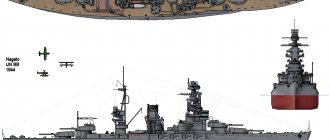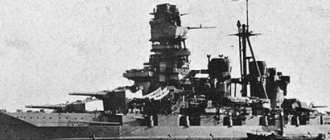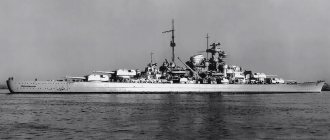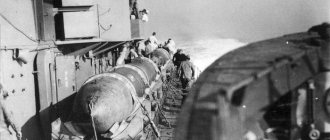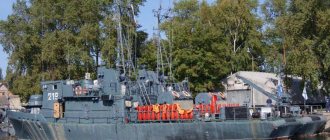Construction and armor of Fuso-class battleships
The appearance of the new dreadnought was reminiscent of the recently built Kongo-class cruisers. At the same time, the level of protection and firepower corresponded to modern battleships. The maximum length of the vessel was 202.7 meters, the total displacement was 35,900 tons. The power plant in the form of two Brown-Curtis turbines and 24 steam boilers provided 40,000 hp. This allowed the ship to accelerate to a speed of 23 knots. In economy mode, the battleship could travel about 8,000 miles. At the time of Fuso's launch, no European dreadnought had similar characteristics.
The hull's armor was also strengthened. The main armor belt had a thickness identical to the previous Kawachi - 305 mm. The rest of the outer part of the deck was sheathed with 203 and 152 mm sheets. The main caliber turret superstructures were protected by 203 mm steel, but the guns themselves had 305 mm armor. The deck's protective covering was also increased.
Armament of Fuso-class battleships
America began to use 356 mm guns as the main caliber. Britain and Germany also increased their weapons capacity. Japan kept pace with the times and began using 356 mm artillery on the Fuso. The guns were installed according to the 2-1-1-2 pattern. Twin two-gun superstructures of a linearly elevated design were placed at the bow and stern of the vessel. In the same parallel with them in the center of the battleships there was another tower with two cannons on each. With such a system, if an enemy appeared on the side of the dreadnought, it became possible to use all 12 units of equipment.
"Fuso" was equipped with the following weapons:
- 12 naval guns with a caliber of 356 mm. The maximum firing range was 28 km.
- 14 152-mm guns acted as anti-mine artillery. The projectile could fly 14 km.
- 4 twin mounts of 127 mm air defense guns.
- 25-mm anti-aircraft guns were presented in three versions: a system with a triple, double and single muzzle. The total number of gun barrels was 60 units.
Battleship "Fuso": kill the enemy before the battle begins
In the process of modernizing the battleship Fuso, the designers were faced with a lack of space to install modern surveillance, communications and fire control equipment.
Six main caliber towers, distributed along the entire length of the ship, prevented the placement of additional bridges, deckhouses and rangefinder posts. The only way out of the situation was an indomitable upward movement. After the first modernization (1930-1933), the Fuso superstructure rose 40 meters above the deck, becoming the highest in the world. The unusual type of superstructure went down in history under the name “pagoda,” thereby emphasizing the national Japanese flavor.
The accumulation of tiers created a false sense of chaos. However, the pagoda was an elaborate structure designed to solve purely practical problems. The Japanese solved the problem of lack of space on the upper deck, while simultaneously providing the combat posts with excellent visibility.
The lowest tier was occupied by a spare fire control bridge for medium-caliber artillery. Just above it was a compass bridge. Even higher is an observation post with three powerful 18-cm binoculars and a signal spotlight. The next level is a reserve fire control post for main caliber artillery.
Above was the main fire control post for the main battery artillery: a stabilized central sight with a crew of six numbers, a “sokutekiban” (for determining the course and speed of the target) and observation instruments.
Further up is a rangefinder bridge with a 10-meter rangefinder moving on rails. From this tier there was access to the signal yards.
The space above the rangefinder bridge was occupied by a combat bridge with binoculars.
The top floor was a central observation post with a direction finder antenna. And at the very top of the “pagoda” there is a masthead fire.
In the spring of 1945, after the destruction of the Yamato ship, the battleship Fuso became the flagship of the United Fleet. The new assignment entailed further changes in the design of the battleship - its “pagoda” grew in height, allowing the placement of additional transmitters and a flagship command post (FCP).
The planned modernization of the battleship was delayed due to a lack of funds after Japan's defeat in the war. The required amount (10 trillion yen) was collected only by the beginning of the 60s, and, in the chilly autumn of 1962, “Fuso” was docked at the Kure Naval Arsenal.
The need for urgent modernization was caused by the development of guided weapons. The main direction of modernization was to increase the height of the “pagoda” simultaneously with boosting the battleship’s power plant three times (up to 240 thousand hp), which, according to calculations, should have provided an increase in speed of 4 knots.
At an altitude of 100 meters above sea level there are space communication bridges at VHF frequencies, general detection radars and stabilized target illumination radar posts. One of the main elements in the design of the “pagoda” was the additional (seventh) main caliber tower, located in the middle part of the superstructure, between the electronic intelligence and signal stroboscope bridges.
Looking at the majestic Fuso Pagoda, the great thinker and poet Tomimo Tokoso composed his poem “The Castle of the Seven Towers”:
I will die for the great Nippon - I will leave my wife only debts, and three Tamagotchis, a little less...
The 80th anniversary of the battleship, celebrated in a solemn ceremony in 1995, coincided with a new extensive modernization program for Fuso. By the end of the 90s. the height of its superstructure reached 400 meters, thanks to which the battleship completely switched to renewable energy sources. The entire upper part of the Fuso superstructure is occupied by bridges of wind generators and solar panels.
Currently, experiments are being conducted on board to create weapons based on new physical principles. A self-defense system that diverts enemy missiles into space with a different metric, and an accelerator of superluminal particles (tachyons), which disrupt cause-and-effect relationships and kill the enemy before the start of the battle.
Modernization of Fuso-class battleships
Several improvements were made to the dreadnoughts during their service. The superstructure was enlarged; 127 mm anti-aircraft weapons were placed in the rear part, as well as additional artillery control points.
Underwater protection has been improved and bulkheads have been added to the bottom. The ship itself has also been enlarged. Its length reached 212 meters, its carrying capacity increased by 4000 tons. The deck armor was strengthened to 114 mm.
Aviation appeared on the dreadnought. Three aircraft performed reconnaissance functions. A catapult was installed on one of the towers. There were no hangars for biplanes; they were located in an open area.
Fuso (battleship)
Pre-war period
"Fuso" was laid down at the naval shipyard in Kure on March 11, 1912 and launched on March 28, 1914. The ship was commissioned on November 8, 1915. On December 13 he enlisted in the 1st Division of the 1st Fleet. The ship did not take part in hostilities during the First World War, since there were no longer the forces of the Central Powers in Asia. Until the end of the war, the battleship was engaged in patrolling off the coast of China. In 1917 and 1918, Fuso served as the flagship of the 1st Division. The battleship was put into reserve. In 1918, five 76.2 mm anti-aircraft guns were installed on the ship. From September 9 to 22, 1923, Fuso participated in the rescue of victims of the Great Kanto Earthquake. From July 1, 1924 to November 1, the ship was commanded by Captain Mitsumasa Yonai, the future Prime Minister of Japan. On November 1, Captain Sankichi Takahashi took command. In the 1920s, Fuso conducted combat training off the coast of China and was often in reserve.
The first stage of the first modernization began on April 12, 1930 at the Yokosuka shipyard. During the modernization, vehicles were replaced, armor was strengthened, and anti-torpedo bulges were strengthened. On September 26, 1932, Fuso arrived in Kure, where the weapons were updated and the torpedo tubes were dismantled. On May 12, 1933, sea trials began. The second stage of the ship's modernization took place a year later, during which the battleship was lengthened. In March 1935, the reconstruction was completed. In 1936 - 1937, Fuso served as a training ship.
On February 26, 1937, the second modernization of the ship began. On December 1, Captain Hiroaki Abe took command of the battleship. On April 1, 1938, the reconstruction was completed. On November 15, the ship was again assigned to the 1st Division of the 1st Fleet. She operated briefly in Chinese waters in early 1939. On December 12, 1940, the second stage of the second modernization began. By April 10, 1941, all modernization work on Fuso was completed. The updated ship entered the 2nd Division of the 1st Fleet. On September 15, Captain Mitsuo Kinoshita took command of the battleship Fuso. At that time, the 2nd Division consisted of two Fuso-class battleships and two Ise-class battleships.
The Second World War
Last trip
Fuso
and
Mogami
under air attack during the Battle of Surigao Strait Battle of Surigao Bay (Diagram)
Under the command of Rear Admiral Masami Ban, Fuso departed Brunei on 22 October 1944 and, as part of the Southern Group, headed east into the Sulu Sea and then northeast into the Mindanao Sea, intending to join Vice Admiral Takeo Kurita's forces in Leyte Gulf. . The ships sailed west of the island of Mindanao into the Surigao Strait, where they met a large American force. The Battle of Surigao Strait was the most important event in the Battle of Leyte Gulf.
On October 24 at 09:08, Fuso, Yamashiro and the heavy cruiser Mogami spotted a group of 27 aircraft, including TBF Avenger torpedo bombers and SB2C Helldiver dive bombers, accompanied by F6F Hellcat carrier-based fighters. A bomb from one of the planes hit the Fuso, destroying the catapult and both seaplanes. Another bomb hit the ship near tower No. 2 and broke the deck, killing many sailors at the auxiliary artillery posts.
Early the next morning at 1:05 am, Fuso opened fire on the port side and hit the cruiser Mogami. Three sailors were killed in the Mogami infirmary by “friendly fire” from the battleship.
At 2:00 the attacks of the American destroyers began, they fired 27 torpedoes and at 2:07 one or two torpedoes hit the starboard side of the Fuso. The ship began to list to starboard, slowed down and fell out of action. Eyewitnesses later claimed that the Fuso broke in half, and that both halves remained afloat and burned for an hour. But witnesses could only see fire on the water, and not any fragments of the ship. Historian John Toland argued in 1970 that the Fuso broke in half. According to research by historian Anthony Tully, published in 2009 and based on the Hutchins' logbook, which describes the sinking of the Fuso, "a huge explosion at 03:38 rose above the ship, so that it seemed to break in half ..."
It is known for certain that the battleship was torpedoed and, as a result of intense flooding, capsized and sank within forty minutes. The Fuso sank between 3:38 and 3:50, with only a few dozen survivors from its crew. There is evidence that some of them were rescued by the destroyer Asagumo, which itself sank some time later. Ten members of the battleship's crew were able to return to Japan.
On August 31, 1945, Fuso was removed from the fleet lists.
